Investment Appraisal: Capital Budgeting and Strategic Control
VerifiedAdded on 2023/04/25
|7
|1609
|137
Report
AI Summary
This report provides an overview of capital budgeting and strategic control, focusing on investment appraisal techniques. It discusses key concepts such as Net Present Value (NPV), payback period, discounted payback period, and profitability index. The report includes a cash flow analysis for Berry Mount Manufactures, demonstrating the application of these techniques. Sensitivity and scenario analyses are highlighted as crucial for assessing project viability under varying conditions. Ultimately, the report recommends that Berry Mount accept the project based on its positive NPV, high internal rate of return, and reasonable payback period, emphasizing the importance of comprehensive assessment in investment decision-making. Desklib offers a wealth of resources, including past papers and solved assignments, to aid students in mastering these complex financial concepts.
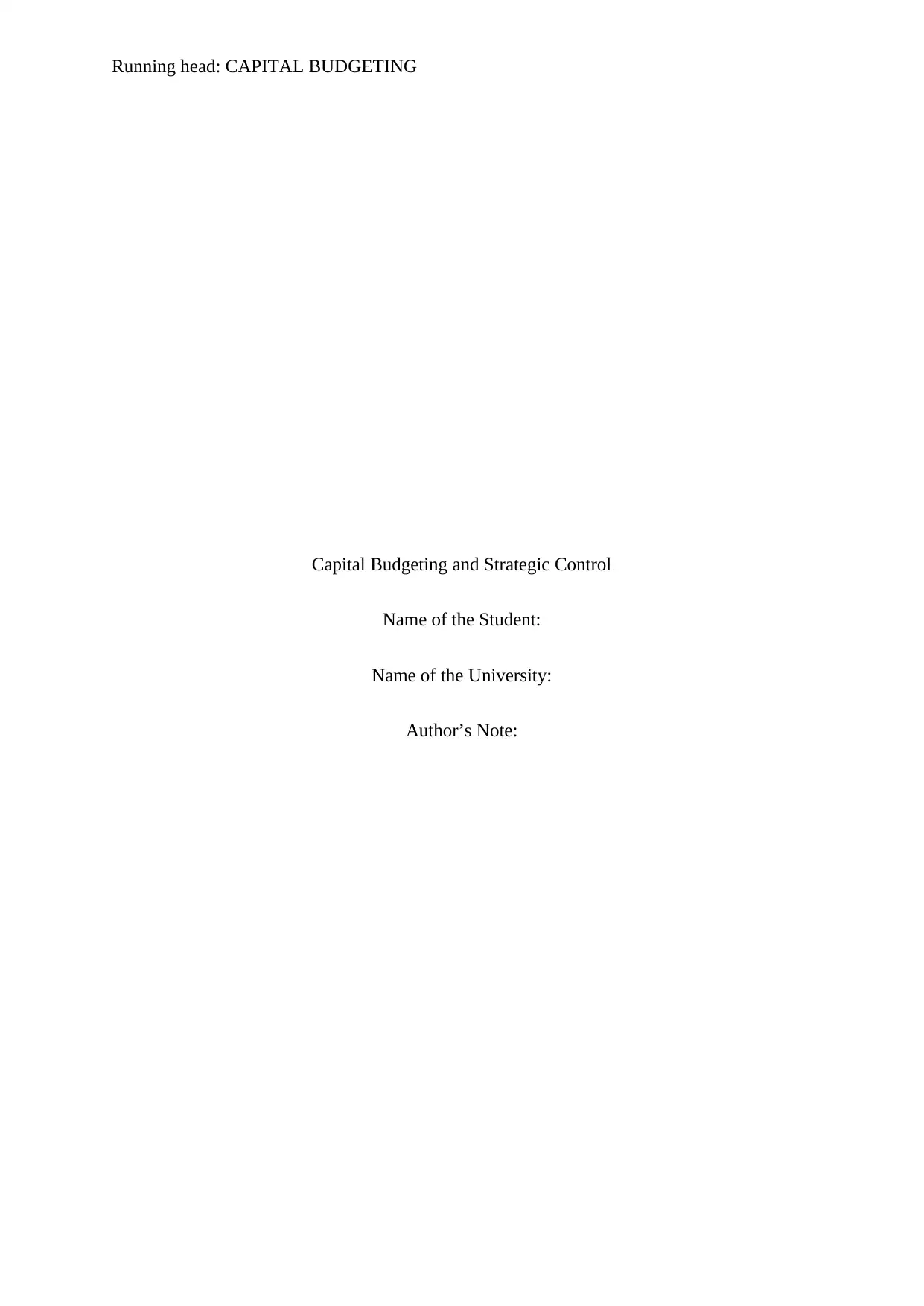
Running head: CAPITAL BUDGETING
Capital Budgeting and Strategic Control
Name of the Student:
Name of the University:
Author’s Note:
Capital Budgeting and Strategic Control
Name of the Student:
Name of the University:
Author’s Note:
Paraphrase This Document
Need a fresh take? Get an instant paraphrase of this document with our AI Paraphraser
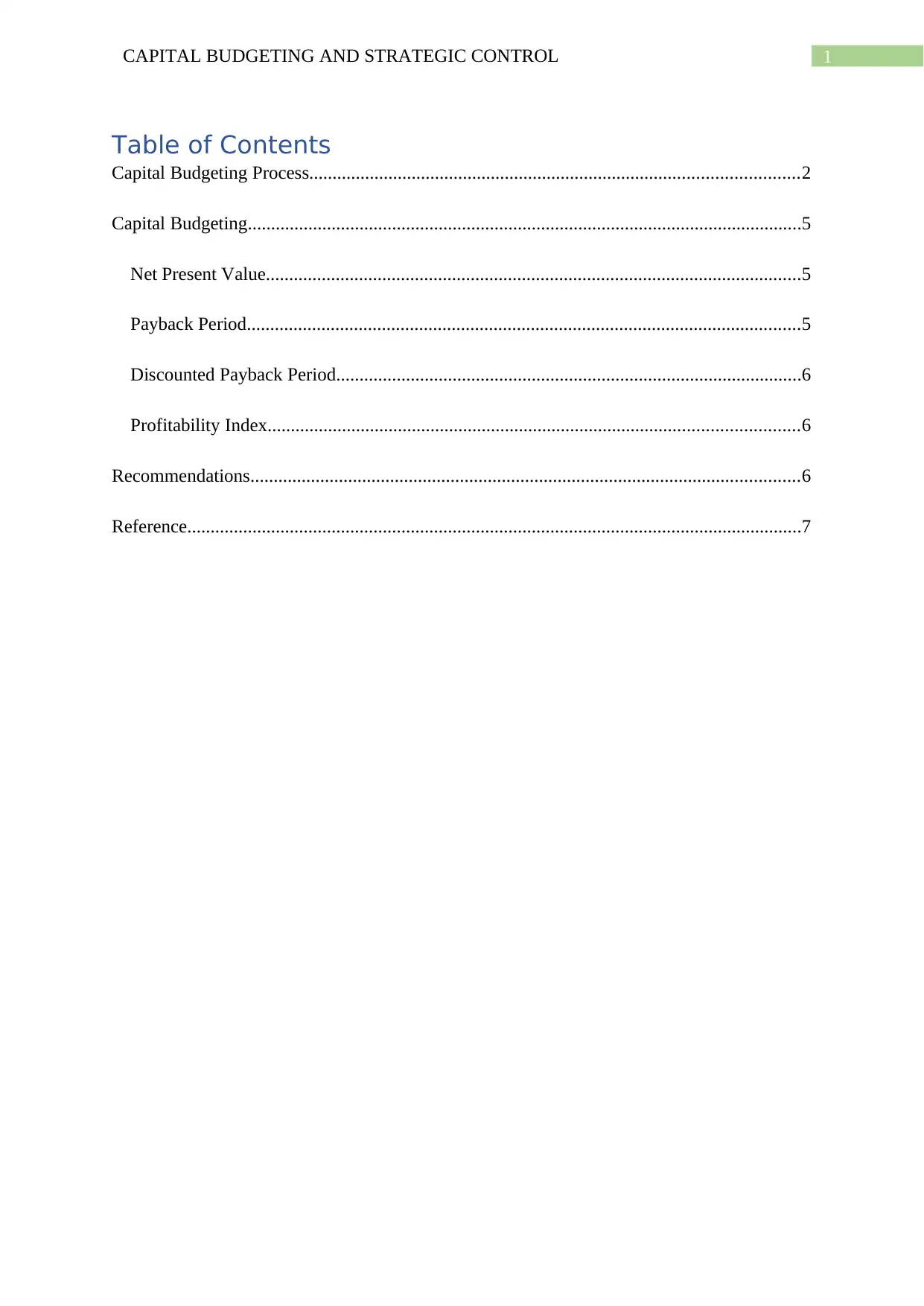
1CAPITAL BUDGETING AND STRATEGIC CONTROL
Table of Contents
Capital Budgeting Process.........................................................................................................2
Capital Budgeting.......................................................................................................................5
Net Present Value...................................................................................................................5
Payback Period.......................................................................................................................5
Discounted Payback Period....................................................................................................6
Profitability Index..................................................................................................................6
Recommendations......................................................................................................................6
Reference....................................................................................................................................7
Table of Contents
Capital Budgeting Process.........................................................................................................2
Capital Budgeting.......................................................................................................................5
Net Present Value...................................................................................................................5
Payback Period.......................................................................................................................5
Discounted Payback Period....................................................................................................6
Profitability Index..................................................................................................................6
Recommendations......................................................................................................................6
Reference....................................................................................................................................7
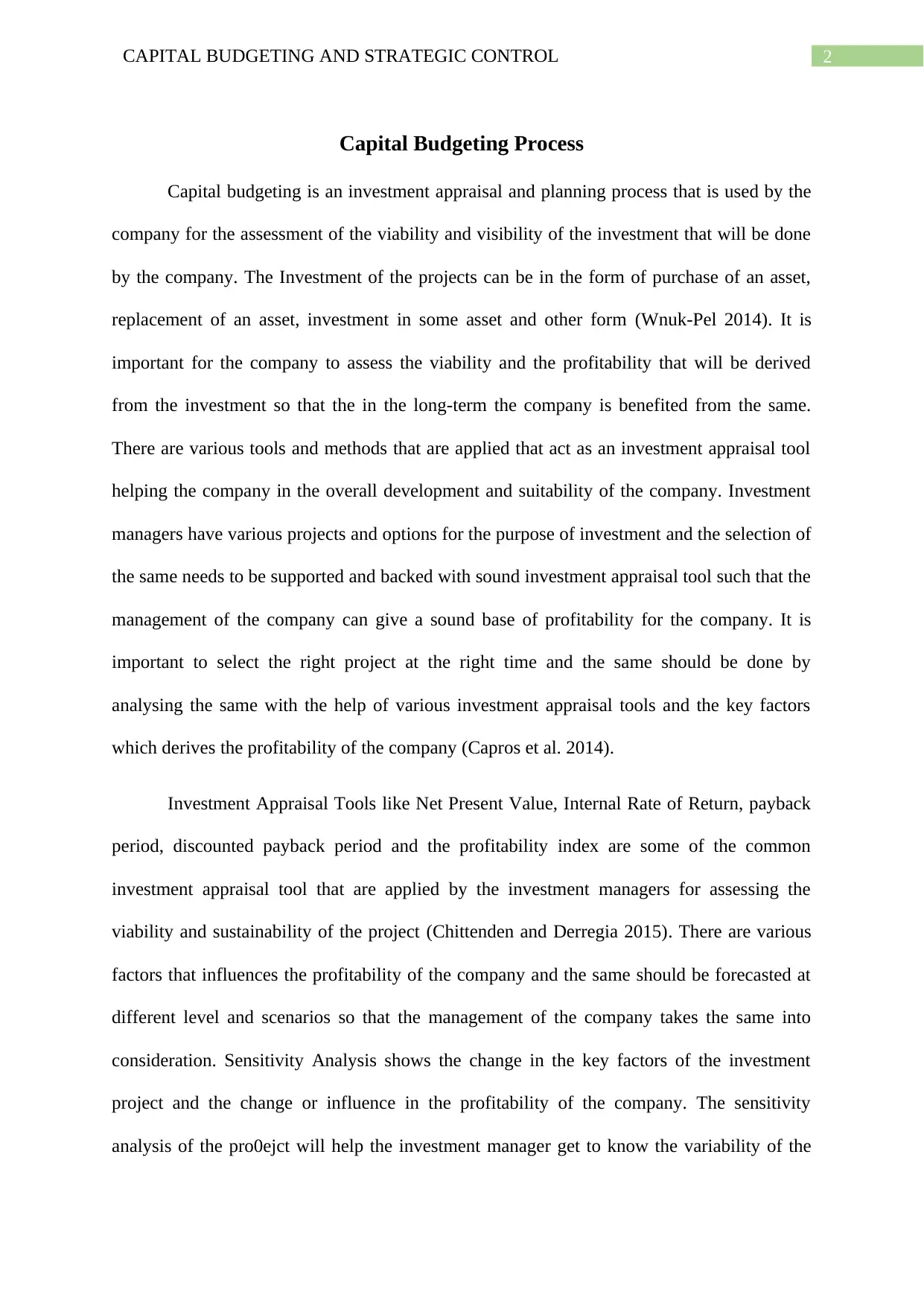
2CAPITAL BUDGETING AND STRATEGIC CONTROL
Capital Budgeting Process
Capital budgeting is an investment appraisal and planning process that is used by the
company for the assessment of the viability and visibility of the investment that will be done
by the company. The Investment of the projects can be in the form of purchase of an asset,
replacement of an asset, investment in some asset and other form (Wnuk-Pel 2014). It is
important for the company to assess the viability and the profitability that will be derived
from the investment so that the in the long-term the company is benefited from the same.
There are various tools and methods that are applied that act as an investment appraisal tool
helping the company in the overall development and suitability of the company. Investment
managers have various projects and options for the purpose of investment and the selection of
the same needs to be supported and backed with sound investment appraisal tool such that the
management of the company can give a sound base of profitability for the company. It is
important to select the right project at the right time and the same should be done by
analysing the same with the help of various investment appraisal tools and the key factors
which derives the profitability of the company (Capros et al. 2014).
Investment Appraisal Tools like Net Present Value, Internal Rate of Return, payback
period, discounted payback period and the profitability index are some of the common
investment appraisal tool that are applied by the investment managers for assessing the
viability and sustainability of the project (Chittenden and Derregia 2015). There are various
factors that influences the profitability of the company and the same should be forecasted at
different level and scenarios so that the management of the company takes the same into
consideration. Sensitivity Analysis shows the change in the key factors of the investment
project and the change or influence in the profitability of the company. The sensitivity
analysis of the pro0ejct will help the investment manager get to know the variability of the
Capital Budgeting Process
Capital budgeting is an investment appraisal and planning process that is used by the
company for the assessment of the viability and visibility of the investment that will be done
by the company. The Investment of the projects can be in the form of purchase of an asset,
replacement of an asset, investment in some asset and other form (Wnuk-Pel 2014). It is
important for the company to assess the viability and the profitability that will be derived
from the investment so that the in the long-term the company is benefited from the same.
There are various tools and methods that are applied that act as an investment appraisal tool
helping the company in the overall development and suitability of the company. Investment
managers have various projects and options for the purpose of investment and the selection of
the same needs to be supported and backed with sound investment appraisal tool such that the
management of the company can give a sound base of profitability for the company. It is
important to select the right project at the right time and the same should be done by
analysing the same with the help of various investment appraisal tools and the key factors
which derives the profitability of the company (Capros et al. 2014).
Investment Appraisal Tools like Net Present Value, Internal Rate of Return, payback
period, discounted payback period and the profitability index are some of the common
investment appraisal tool that are applied by the investment managers for assessing the
viability and sustainability of the project (Chittenden and Derregia 2015). There are various
factors that influences the profitability of the company and the same should be forecasted at
different level and scenarios so that the management of the company takes the same into
consideration. Sensitivity Analysis shows the change in the key factors of the investment
project and the change or influence in the profitability of the company. The sensitivity
analysis of the pro0ejct will help the investment manager get to know the variability of the
⊘ This is a preview!⊘
Do you want full access?
Subscribe today to unlock all pages.

Trusted by 1+ million students worldwide
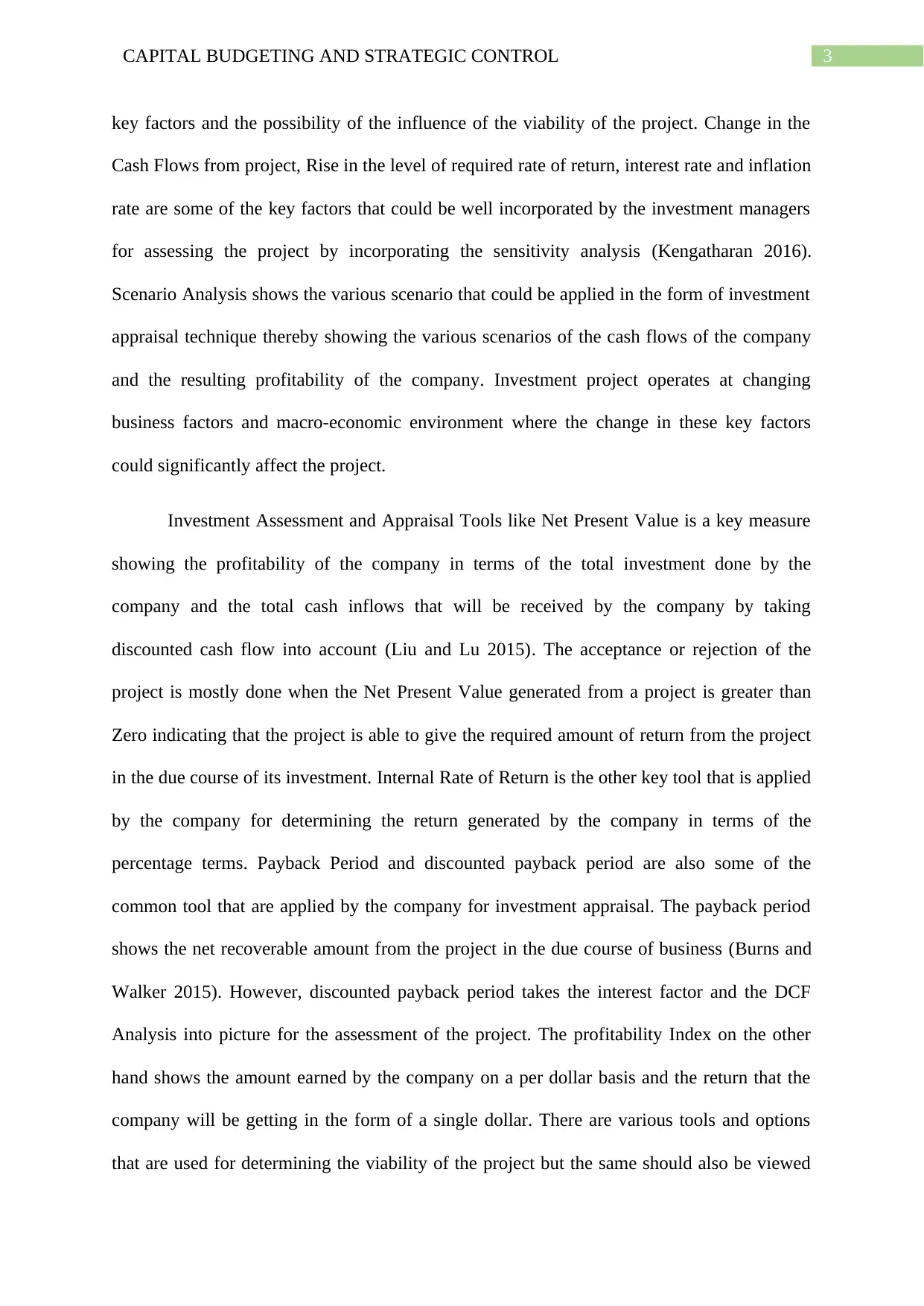
3CAPITAL BUDGETING AND STRATEGIC CONTROL
key factors and the possibility of the influence of the viability of the project. Change in the
Cash Flows from project, Rise in the level of required rate of return, interest rate and inflation
rate are some of the key factors that could be well incorporated by the investment managers
for assessing the project by incorporating the sensitivity analysis (Kengatharan 2016).
Scenario Analysis shows the various scenario that could be applied in the form of investment
appraisal technique thereby showing the various scenarios of the cash flows of the company
and the resulting profitability of the company. Investment project operates at changing
business factors and macro-economic environment where the change in these key factors
could significantly affect the project.
Investment Assessment and Appraisal Tools like Net Present Value is a key measure
showing the profitability of the company in terms of the total investment done by the
company and the total cash inflows that will be received by the company by taking
discounted cash flow into account (Liu and Lu 2015). The acceptance or rejection of the
project is mostly done when the Net Present Value generated from a project is greater than
Zero indicating that the project is able to give the required amount of return from the project
in the due course of its investment. Internal Rate of Return is the other key tool that is applied
by the company for determining the return generated by the company in terms of the
percentage terms. Payback Period and discounted payback period are also some of the
common tool that are applied by the company for investment appraisal. The payback period
shows the net recoverable amount from the project in the due course of business (Burns and
Walker 2015). However, discounted payback period takes the interest factor and the DCF
Analysis into picture for the assessment of the project. The profitability Index on the other
hand shows the amount earned by the company on a per dollar basis and the return that the
company will be getting in the form of a single dollar. There are various tools and options
that are used for determining the viability of the project but the same should also be viewed
key factors and the possibility of the influence of the viability of the project. Change in the
Cash Flows from project, Rise in the level of required rate of return, interest rate and inflation
rate are some of the key factors that could be well incorporated by the investment managers
for assessing the project by incorporating the sensitivity analysis (Kengatharan 2016).
Scenario Analysis shows the various scenario that could be applied in the form of investment
appraisal technique thereby showing the various scenarios of the cash flows of the company
and the resulting profitability of the company. Investment project operates at changing
business factors and macro-economic environment where the change in these key factors
could significantly affect the project.
Investment Assessment and Appraisal Tools like Net Present Value is a key measure
showing the profitability of the company in terms of the total investment done by the
company and the total cash inflows that will be received by the company by taking
discounted cash flow into account (Liu and Lu 2015). The acceptance or rejection of the
project is mostly done when the Net Present Value generated from a project is greater than
Zero indicating that the project is able to give the required amount of return from the project
in the due course of its investment. Internal Rate of Return is the other key tool that is applied
by the company for determining the return generated by the company in terms of the
percentage terms. Payback Period and discounted payback period are also some of the
common tool that are applied by the company for investment appraisal. The payback period
shows the net recoverable amount from the project in the due course of business (Burns and
Walker 2015). However, discounted payback period takes the interest factor and the DCF
Analysis into picture for the assessment of the project. The profitability Index on the other
hand shows the amount earned by the company on a per dollar basis and the return that the
company will be getting in the form of a single dollar. There are various tools and options
that are used for determining the viability of the project but the same should also be viewed
Paraphrase This Document
Need a fresh take? Get an instant paraphrase of this document with our AI Paraphraser
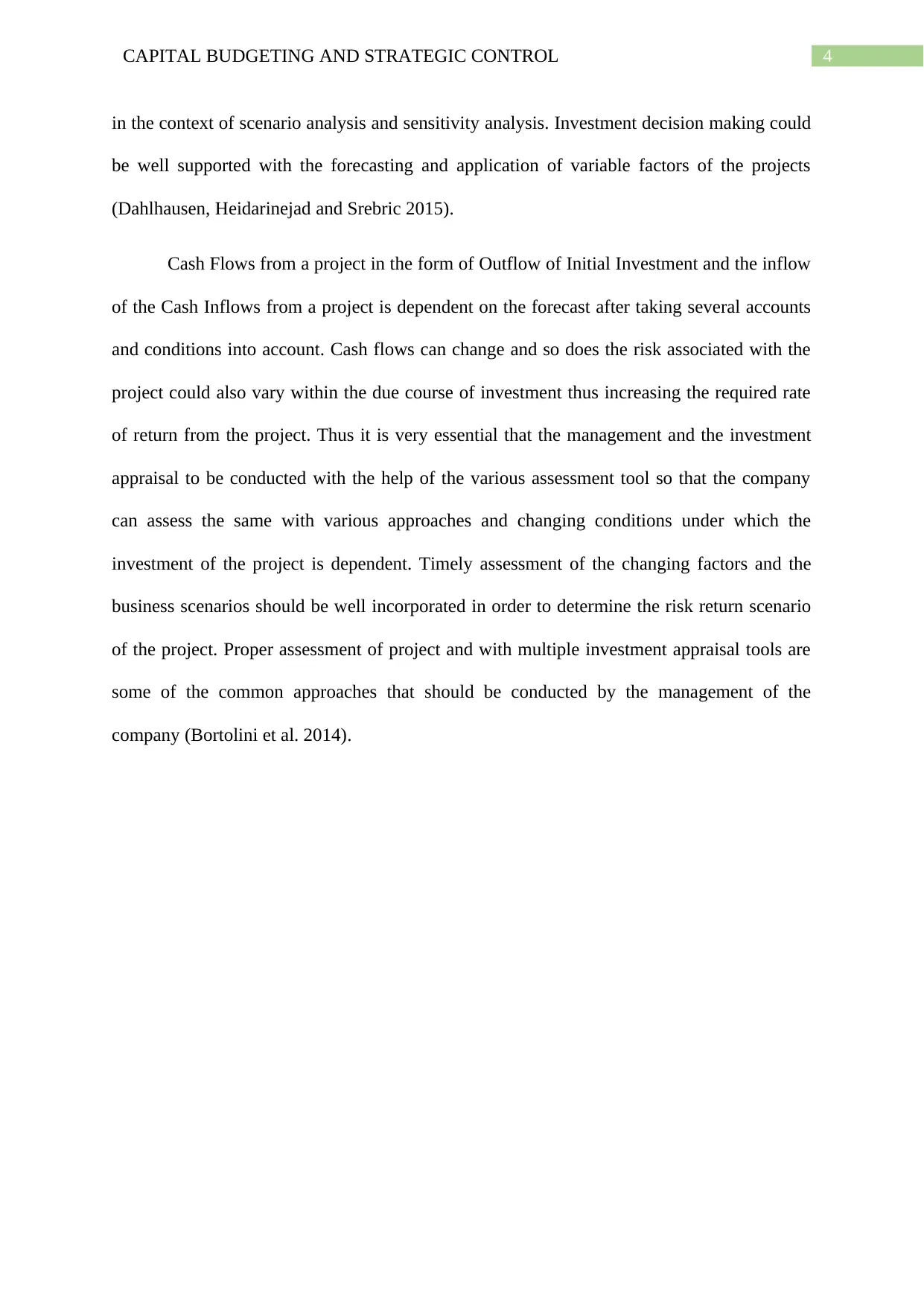
4CAPITAL BUDGETING AND STRATEGIC CONTROL
in the context of scenario analysis and sensitivity analysis. Investment decision making could
be well supported with the forecasting and application of variable factors of the projects
(Dahlhausen, Heidarinejad and Srebric 2015).
Cash Flows from a project in the form of Outflow of Initial Investment and the inflow
of the Cash Inflows from a project is dependent on the forecast after taking several accounts
and conditions into account. Cash flows can change and so does the risk associated with the
project could also vary within the due course of investment thus increasing the required rate
of return from the project. Thus it is very essential that the management and the investment
appraisal to be conducted with the help of the various assessment tool so that the company
can assess the same with various approaches and changing conditions under which the
investment of the project is dependent. Timely assessment of the changing factors and the
business scenarios should be well incorporated in order to determine the risk return scenario
of the project. Proper assessment of project and with multiple investment appraisal tools are
some of the common approaches that should be conducted by the management of the
company (Bortolini et al. 2014).
in the context of scenario analysis and sensitivity analysis. Investment decision making could
be well supported with the forecasting and application of variable factors of the projects
(Dahlhausen, Heidarinejad and Srebric 2015).
Cash Flows from a project in the form of Outflow of Initial Investment and the inflow
of the Cash Inflows from a project is dependent on the forecast after taking several accounts
and conditions into account. Cash flows can change and so does the risk associated with the
project could also vary within the due course of investment thus increasing the required rate
of return from the project. Thus it is very essential that the management and the investment
appraisal to be conducted with the help of the various assessment tool so that the company
can assess the same with various approaches and changing conditions under which the
investment of the project is dependent. Timely assessment of the changing factors and the
business scenarios should be well incorporated in order to determine the risk return scenario
of the project. Proper assessment of project and with multiple investment appraisal tools are
some of the common approaches that should be conducted by the management of the
company (Bortolini et al. 2014).
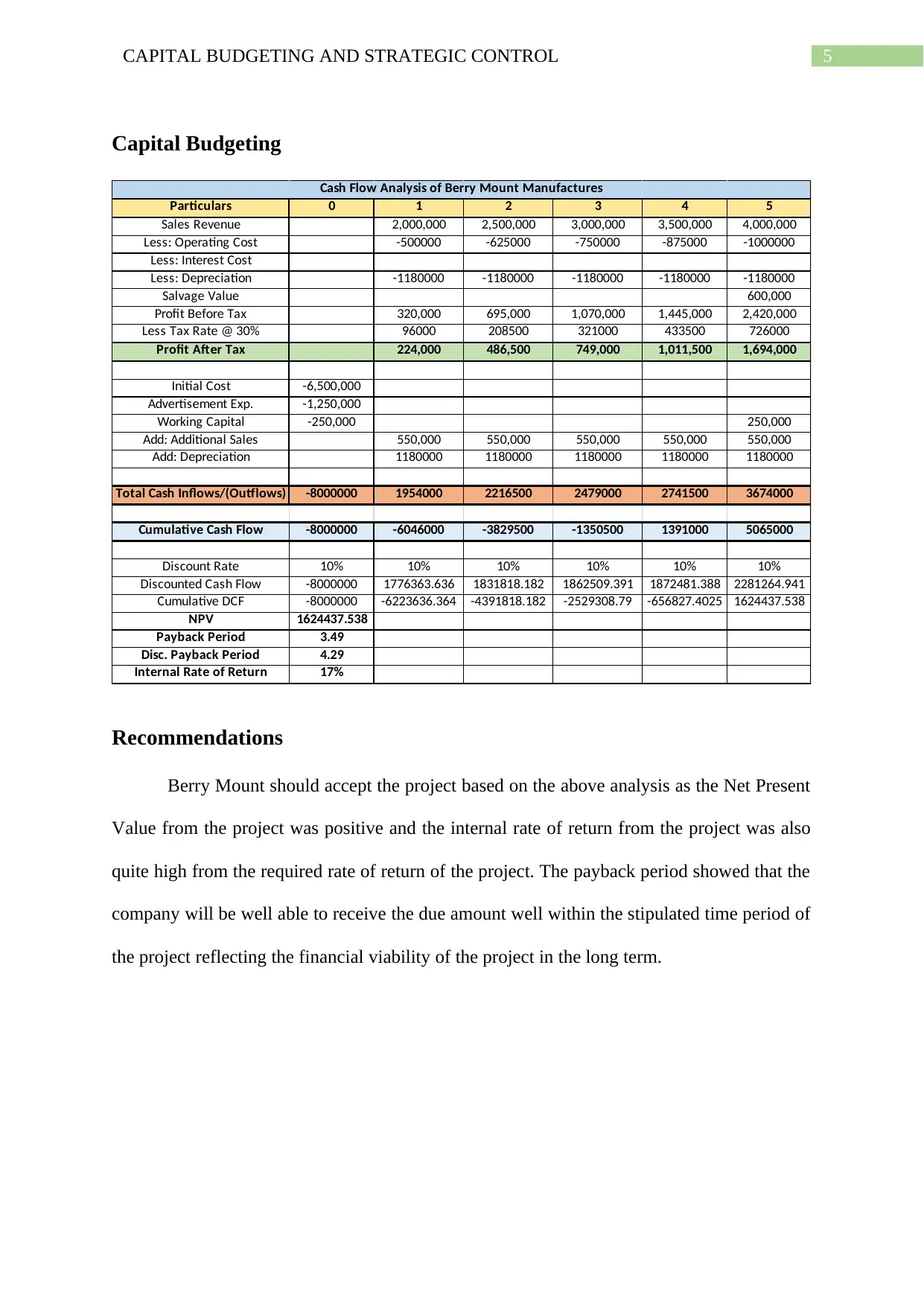
5CAPITAL BUDGETING AND STRATEGIC CONTROL
Capital Budgeting
Particulars 0 1 2 3 4 5
Sales Revenue 2,000,000 2,500,000 3,000,000 3,500,000 4,000,000
Less: Operating Cost -500000 -625000 -750000 -875000 -1000000
Less: Interest Cost
Less: Depreciation -1180000 -1180000 -1180000 -1180000 -1180000
Salvage Value 600,000
Profit Before Tax 320,000 695,000 1,070,000 1,445,000 2,420,000
Less Tax Rate @ 30% 96000 208500 321000 433500 726000
Profit After Tax 224,000 486,500 749,000 1,011,500 1,694,000
Initial Cost -6,500,000
Advertisement Exp. -1,250,000
Working Capital -250,000 250,000
Add: Additional Sales 550,000 550,000 550,000 550,000 550,000
Add: Depreciation 1180000 1180000 1180000 1180000 1180000
Total Cash Inflows/(Outflows) -8000000 1954000 2216500 2479000 2741500 3674000
Cumulative Cash Flow -8000000 -6046000 -3829500 -1350500 1391000 5065000
Discount Rate 10% 10% 10% 10% 10% 10%
Discounted Cash Flow -8000000 1776363.636 1831818.182 1862509.391 1872481.388 2281264.941
Cumulative DCF -8000000 -6223636.364 -4391818.182 -2529308.79 -656827.4025 1624437.538
NPV 1624437.538
Payback Period 3.49
Disc. Payback Period 4.29
Internal Rate of Return 17%
Cash Flow Analysis of Berry Mount Manufactures
Recommendations
Berry Mount should accept the project based on the above analysis as the Net Present
Value from the project was positive and the internal rate of return from the project was also
quite high from the required rate of return of the project. The payback period showed that the
company will be well able to receive the due amount well within the stipulated time period of
the project reflecting the financial viability of the project in the long term.
Capital Budgeting
Particulars 0 1 2 3 4 5
Sales Revenue 2,000,000 2,500,000 3,000,000 3,500,000 4,000,000
Less: Operating Cost -500000 -625000 -750000 -875000 -1000000
Less: Interest Cost
Less: Depreciation -1180000 -1180000 -1180000 -1180000 -1180000
Salvage Value 600,000
Profit Before Tax 320,000 695,000 1,070,000 1,445,000 2,420,000
Less Tax Rate @ 30% 96000 208500 321000 433500 726000
Profit After Tax 224,000 486,500 749,000 1,011,500 1,694,000
Initial Cost -6,500,000
Advertisement Exp. -1,250,000
Working Capital -250,000 250,000
Add: Additional Sales 550,000 550,000 550,000 550,000 550,000
Add: Depreciation 1180000 1180000 1180000 1180000 1180000
Total Cash Inflows/(Outflows) -8000000 1954000 2216500 2479000 2741500 3674000
Cumulative Cash Flow -8000000 -6046000 -3829500 -1350500 1391000 5065000
Discount Rate 10% 10% 10% 10% 10% 10%
Discounted Cash Flow -8000000 1776363.636 1831818.182 1862509.391 1872481.388 2281264.941
Cumulative DCF -8000000 -6223636.364 -4391818.182 -2529308.79 -656827.4025 1624437.538
NPV 1624437.538
Payback Period 3.49
Disc. Payback Period 4.29
Internal Rate of Return 17%
Cash Flow Analysis of Berry Mount Manufactures
Recommendations
Berry Mount should accept the project based on the above analysis as the Net Present
Value from the project was positive and the internal rate of return from the project was also
quite high from the required rate of return of the project. The payback period showed that the
company will be well able to receive the due amount well within the stipulated time period of
the project reflecting the financial viability of the project in the long term.
⊘ This is a preview!⊘
Do you want full access?
Subscribe today to unlock all pages.

Trusted by 1+ million students worldwide
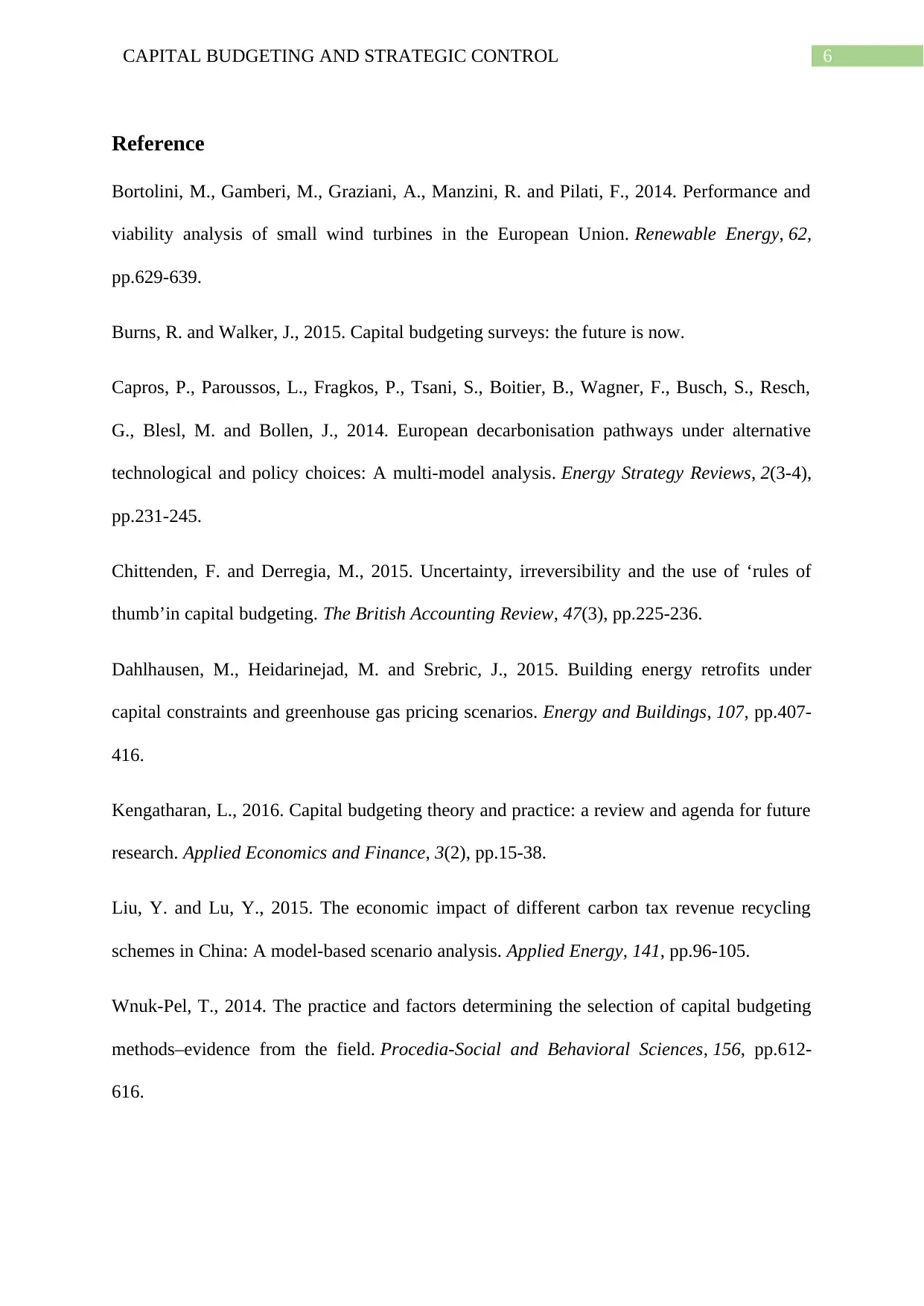
6CAPITAL BUDGETING AND STRATEGIC CONTROL
Reference
Bortolini, M., Gamberi, M., Graziani, A., Manzini, R. and Pilati, F., 2014. Performance and
viability analysis of small wind turbines in the European Union. Renewable Energy, 62,
pp.629-639.
Burns, R. and Walker, J., 2015. Capital budgeting surveys: the future is now.
Capros, P., Paroussos, L., Fragkos, P., Tsani, S., Boitier, B., Wagner, F., Busch, S., Resch,
G., Blesl, M. and Bollen, J., 2014. European decarbonisation pathways under alternative
technological and policy choices: A multi-model analysis. Energy Strategy Reviews, 2(3-4),
pp.231-245.
Chittenden, F. and Derregia, M., 2015. Uncertainty, irreversibility and the use of ‘rules of
thumb’in capital budgeting. The British Accounting Review, 47(3), pp.225-236.
Dahlhausen, M., Heidarinejad, M. and Srebric, J., 2015. Building energy retrofits under
capital constraints and greenhouse gas pricing scenarios. Energy and Buildings, 107, pp.407-
416.
Kengatharan, L., 2016. Capital budgeting theory and practice: a review and agenda for future
research. Applied Economics and Finance, 3(2), pp.15-38.
Liu, Y. and Lu, Y., 2015. The economic impact of different carbon tax revenue recycling
schemes in China: A model-based scenario analysis. Applied Energy, 141, pp.96-105.
Wnuk-Pel, T., 2014. The practice and factors determining the selection of capital budgeting
methods–evidence from the field. Procedia-Social and Behavioral Sciences, 156, pp.612-
616.
Reference
Bortolini, M., Gamberi, M., Graziani, A., Manzini, R. and Pilati, F., 2014. Performance and
viability analysis of small wind turbines in the European Union. Renewable Energy, 62,
pp.629-639.
Burns, R. and Walker, J., 2015. Capital budgeting surveys: the future is now.
Capros, P., Paroussos, L., Fragkos, P., Tsani, S., Boitier, B., Wagner, F., Busch, S., Resch,
G., Blesl, M. and Bollen, J., 2014. European decarbonisation pathways under alternative
technological and policy choices: A multi-model analysis. Energy Strategy Reviews, 2(3-4),
pp.231-245.
Chittenden, F. and Derregia, M., 2015. Uncertainty, irreversibility and the use of ‘rules of
thumb’in capital budgeting. The British Accounting Review, 47(3), pp.225-236.
Dahlhausen, M., Heidarinejad, M. and Srebric, J., 2015. Building energy retrofits under
capital constraints and greenhouse gas pricing scenarios. Energy and Buildings, 107, pp.407-
416.
Kengatharan, L., 2016. Capital budgeting theory and practice: a review and agenda for future
research. Applied Economics and Finance, 3(2), pp.15-38.
Liu, Y. and Lu, Y., 2015. The economic impact of different carbon tax revenue recycling
schemes in China: A model-based scenario analysis. Applied Energy, 141, pp.96-105.
Wnuk-Pel, T., 2014. The practice and factors determining the selection of capital budgeting
methods–evidence from the field. Procedia-Social and Behavioral Sciences, 156, pp.612-
616.
1 out of 7
Related Documents
Your All-in-One AI-Powered Toolkit for Academic Success.
+13062052269
info@desklib.com
Available 24*7 on WhatsApp / Email
![[object Object]](/_next/static/media/star-bottom.7253800d.svg)
Unlock your academic potential
Copyright © 2020–2025 A2Z Services. All Rights Reserved. Developed and managed by ZUCOL.





